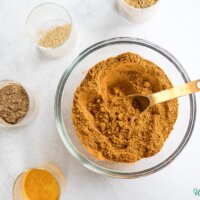I never thought I liked curry powder. I’m not sure where my negative opinion came from, but I once accidentally added it to a soup and discovered I absolutely love it. The unique and complex flavor makes curry powder an incredible addition to meals.
I now add this curry powder recipe to breakfast dishes, like our regular vegetable scramble. I also use it with meats, soups, and roasted veggies. I’ve experimented with adding it to traditional curry dishes, though these definitely aren’t my strength (anyone want to come teach me?).
What Is Curry Powder?
The term “curry” isn’t exactly a clear-cut concept in the food world. We apply it to any number of spicy, saucy dishes and typically associate it with Asian or Indian cuisine. Funny enough, most curry powder seasonings don’t use curry leaves at all but are a mix of various earthy and smoky spices.
The concept of curry originated from the British occupation of India and the Brits labeled the food their Indian curry. So the curry powders of today are really a European interpretation of Indian cooking. Over the years they’ve evolved some, but feature different combinations of various fragrant spices.
You’ll find spice blends with fenugreek seeds, fennel seeds, paprika, ground ginger, mustard seeds, coriander seeds, cayenne pepper, black pepper, chili powder, cumin seeds, bay leaf, garlic powder, and cinnamon. Curry spice blends can use whole spices toasted and then ground in a spice grinder. Other recipes (including this one) use ground spices for a faster version.
Given the health benefits of spices, curry can be a fantastic way to work in a whole array of spices.
How to Make a Mild Curry Powder Seasoning (Or to Taste)
Why make curry powder when you can buy it? One word: heat! Most pre-made curry seasonings I’ve tried pack a lot of heat and spice. This can be tough for small kids especially.
Making your own DIY spice mix allows you to tailor the heat to just the right level for your family. You can also tweak the recipe and leave out any spices you don’t like.
How to Use Curry Powder
There are plenty of traditional Indian recipes and adaptations that work welll with curry powder. It also works well as a seasoning for sweet potatoes, roasted chickpeas, and chicken.
If you don’t think you like curry, it could be you didn’t have the right blend for your tastes. Give making your own curry powder a try. Start by adding it in small amounts to simple recipes like meats, roasted vegetables, or soups and work up from there.

Homemade Curry Powder Recipe
Homemade curry powder has a wonderful complex flavor from the various herbs and spices. A delicious, healthy, and cost effective alternative to store bought curry powder.
Nutrition Facts
Homemade Curry Powder Recipe
Amount Per Serving (1 tsp)
Calories 11
Fat 0.5g
Saturated Fat 0.1g
Polyunsaturated Fat 0.1g
Monounsaturated Fat 0.2g
Sodium 4mg
Potassium 58mg
Carbohydrates 2g
Fiber 1g
Sugar 0.1g
Protein 0.5g
Vitamin A 377IU
Vitamin C 0.4mg
Calcium 14mg
Iron 1mg
* Percent Daily Values are based on a 2000 calorie diet.
Use curry powder on meats, vegetables, or in soups. It’s specially good with chicken, shrimp, or vegetables.
Like this recipe? Check out my new cookbook, or get all my recipes (over 500!) in a personalized weekly meal planner here!
Favorite Curry Recipes to Try
For a house that once avoided curry, we sure have it a lot now! Here are some of our new favorite meals:
What are your favorite dishes to eat with curry? Are there any spices you prefer in yours? Please share below!